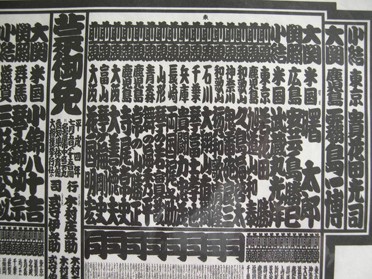| Nagoya Nears Eric Blair |


 |
| Rikishi of Old Joe Kuroda |

 |
| Heya Peek Barbara Ann Klein |


 |
| SFM Interview Mark Buckton |

 |
| Sumo 101 Barbara Ann Klein |
 |
| Photo Bonanza See the Natsu |
 |
| Natsu Basho Summary Lon Howard |

 |
| Lower Division Rikishi Mikko Mattila |

 |
| Nagoya Ones to Watch Mark Buckton |
 |
| Kimarite Focus Mikko Mattila |

 |
| Amateur Angles Howard Gilbert |

 |
| Sumo Game Bruce Rae |
 |
| Sumo in Print Barbara Ann Klein |
 |
| Kokugi Connections Todd Lambert |

 |
| Fan Debate Facilitator – Lon Howard |

 |
| SFM Cartoons Benny Loh & Stephen Thompson |
| Let’s Hear From You What was it that |


 |
| Readers’ Letters |
 |
Sumo Quiz
The Quizmaster
Answer the Qs and win yourself next basho’s banzuke.
Sumo-wise, Nagoya is worth a visit and is, according to sumo folklore, supposedly a place ‘known’ for upsets, which means Nagoyans must have the longest noses in Nippon the amount of times this myth is trotted out. But given a little deeper checking and consideration, it appears the only reason Nagoya is so often referred to as ‘the’ place so much fails to go according to script is that there is absolutely nothing else to say about the city the eleven other months of the year. Bar the numerous miso-based delicacies the locals so covet and boast of, Nagoya when the rikishi depart must be one grey, unappetizing place to live or have to visit. Thus, methinks started the claims of ‘upset,’ ‘unexpected’ and ‘untoward’ – uso*, I respond to such claims – uso!
Admittedly the prefecture of
The heat, of course, plays its role during the basho, but to blame the overworked and overstretched mercury for just about anything and everything that goes askew during the annual tournament is stretching the truth – well, just a tad too far.
a. Only twice in the Heisei Era (we are currently in the 18th year of Heisei) has anyone who didn't go on to ozeki or yokozuna status won the tournament (Kotofuji as M13 and Mitoizumi as M1). Admirable achievements, but 2 of 18? Hardly a common occurrence.
b. Former sekiwake Takamiyama's July 1972 yusho (with a 13-2 record) did make him the first completely non-
Next

July 1992 banzuke – the first banzuke in over 60 years to be headed by ozeki (Akebono and Konishiki) following the May 1992 retirement of yokozuna Hokutoumi (Photo by Mark Buckton)
